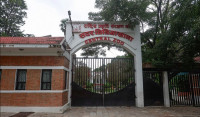Valley
Major parties stand firm with minor divergence
Major parties have taken a firm stand with some minor divergence on Samyukta Loktantrik Madhesi Morcha’s (SLMM) some of the key demands such as constituency delineation, inclusive proportional representation and revision of boundaries.
Major parties have taken a firm stand with some minor divergence on Samyukta Loktantrik Madhesi Morcha’s (SLMM) some of the key demands such as constituency delineation, inclusive proportional representation and revision of boundaries.
Though they have not ruled out negotiations with the agitating SLMM, they do not seem to be willing to address the issues related to boundary demarcation.
During a meeting of the three major parties—ruling CPN-UML and UCPN (M) and the main opposition Nepali Congress—before their talks with the SLMM on Sunday evening, they decided to propose formation of a taskforce comprising second-rung leaders “to work” on the demands put forth by the SLMM, which has refused to buy the idea.
“There are some divergent views in the major parties on details of revisiting boundaries, but they are one on at least one point: demarcation issue cannot be settled right now as demanded by the SLMM,” said a senior Maoist leader.
Though the Maoist party has been saying that the dispute over demarcation should be settled now, it is not in a position to go against the stand taken by the ruling UML, as it is a key partner in the incumbent coalition government.
Three major parties have been trying to sell the idea of forming a cross-party mechanism to sort out issues related to boundary demarcation. Though the SLMM has been positive about the idea, it has questioned whether the mechanism will have “political legitimacy”.
According to a leader, three parties are flexible about splitting Morang, Sunsari and Kailai. Earlier, the UML was dead set against splitting the districts.
“A gentleman’s understanding can be reached on splitting some districts, but the proposed mechanism should take final decisions,” said a UML leader on condition of anonymity.
Regarding constituency delineation, three parties have a common stand that population cannot be the sole basis for it as demanded by the Madhes-based parties.
Three parties want to ensure at least one electoral constituency in 75 districts. The Constitution Amendment Bill tabled in Parliament has the same provision.
Nepali Congress leader Ananda Prasad Dhungana said there should be at least one electoral constituency in 13 remote districts
“We should allocate certain seats for the remote districts of hill and mountain regions. Then we are ready to accept population-based delineation in remaining districts,” said Dhungana. UML leader Pradeep Gyawali echoed Dhungana, saying the proposal was the bottom line of the three parties.
Regarding SLMM’s demand to decrease the current number of ethnic groups in the Right to Social Justice of new constitution, leaders from three parties say they want to remove “youths, workers and others” but are not ready to remove “Khas, Arya” from the list as demanded by Madhes-based parties.
The current provision of Right to Social Justice of new constitution states “under the article pertaining to Right to Social Justice of the new constitution, 21 different groups would be entitled to special protection from the state.”
In the Interim Constitution, there were only eight such groups. SLMM leaders are pressing big parties to decrease the number of groups and include only the ones that were in the Interim Constitution.
A meeting point could be explored through dialogue, said Dhugana.
“In principle we are ready to decrease the number of groups, but we are not ready to remove categories such as “Khas, Arya” because the Madhes movement should not be against these groups,” said Gyawali.




 25.12°C Kathmandu
25.12°C Kathmandu









